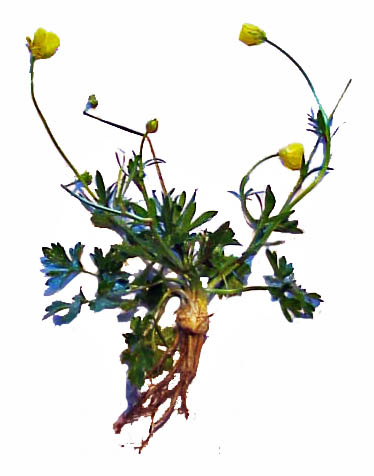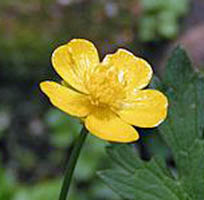So, You Think You Love Horses?
Some Reflections on the Nature of Horses and Man
More Discussions by “The Accidental Horseman”
Buttercups
A Buttercup Plant: Roots and All

|
Buttercups do not particularly enjoy a bad press. However, if you are a horseman you do not want a pasture full of them. Horses find them bitter and unpalatable and usually ignore them. The problem is when the edible plants have been consumed you find yourself with an entire pasture of buttercups. At best they are useless plants that are taking space from grass and nutrients from the soil. Buttercups are known to deplete potassium from soils. Moreover, if there is nothing else to eat sometimes desperate horses will eat them and in that situation they can be poisonous. Symptoms of poisoning include bloody diarrhea, excessive salivation, colic, and severe blistering of the mucous membranes and gastrointestinal tract. I would rather not have any in my pasture. Fortunately, the toxins in Buttercups are degraded by drying, so hay containing dried buttercups or buttercups that are cut down and dried lying in a field are safe if an animal accidently ingests some. All buttercups belong to the genus Ranunculus. The Creeping buttercup (Ranunculaceae repens) is common in this area. It likes wet soil and grows like a weed in wet weather. Once buttercups are established in a pasture there seeds are deposited in the soil and survive several seasons. The plants themselves have the ability to send out running stems, which produce roots and additional new plants.
There are several strategies for controlling buttercups in pastures. Those not involving pesticides include:
- Measures to encourage growth of grass
- Avoid over grazing
- Reduce soil compaction by aerating
- Fertilize during the first half of September, ahead of the fall rains.
- Spread Lime in the fall improves the ability of grass to compete against buttercups
- Good pasture rotation
- Improve drainage of wet areas
Buttercup Flower

|
|
There are a fair number of pesticides that kill buttercups but they are a lot more resistant than many other weeds. Some of these pesticides required commercial licenses and are not available to an unlicensed person maintaining his own pasture. I find 2,4 D (2,4-dichlorophenoxyacetic acid) is effective if applied liberally. According to experts it is safe to allow horses to continue to graze on fields just sprayed with 2,4 D. However, who among us fully trust experts even when maybe we should and would you personally ingest something with a name like 2,4-Dichlorophenoxyacetic acid? Come to think of it have you been reading the names of the things that you are ingesting? Yes, you might think that FD&C Yellow Dye Number 5 does not sound so bad but how about if I call it Trisodium (4E)-5-oxo-1-(4-sulfonatophenyl)-4-[(4-sulfonatophenyl)hydrazono]-3-pyrazolecarboxylate? They are one and the same. The truth is you cannot judge a book by its cover or a chemical substance by its name. Many so-called natural substances have equally long and hard to pronounce chemical names. Many horse lovers, despite the good safety claims regarding 2,4 D, prefer to keep animals off a field sprayed with any pesticide for a period of time and I am among them. People commonly say they use a period 48 hours or until the next rain. However, I cannot say that there is any evidence basis for any of this.
Yours truly,
The Accidental Horseman.
Back to Additional Discussions
Links to Other Sites regarding Horses
Back to Index Page


